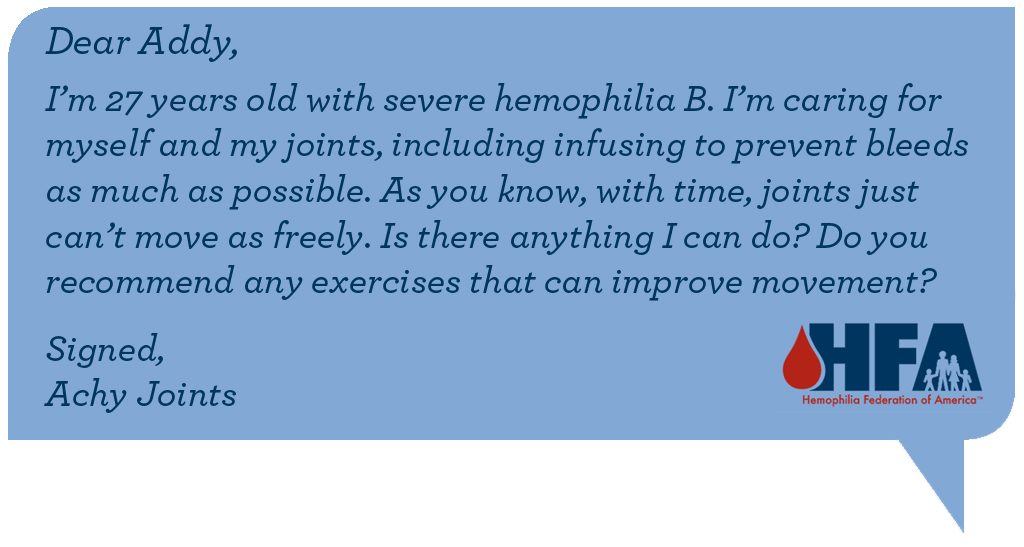
Dear Addy,
I’m 27 years old with severe hemophilia B. I’m caring for myself and my joints, including infusing to prevent bleeds as much as possible. As you know, with time, joints just can’t move as freely. Is there anything I can do? Do you recommend any exercises that can improve movement?
Signed,
Achy Joints
________________________________________________________________________________________
Dear Achy,
Good for you for taking the steps to keep your body healthy and prevent bleeds! It is especially important for individuals with a bleeding disorder to find a form of physical activity that you enjoy. When muscles are used during exercise it helps to keep them flexible and strong and there are several things you can do to improve joint health.
First, move as much as possible. Even if you are sitting at a desk or watching TV, change positions often. The more you move, the less stiff you’ll be. Try to take breaks by stretching or walking.
Secondly, maintaining a healthy weight and proper nutrition can improve your joint health significantly. Certain foods, such as whole grains, dark green leafy vegetables, and fatty fish can lower inflammation. For example, the Omega-3 fatty acids found in fish helps keep joints healthy and reduces inflammation. [1]. Additionally, your size affects how much strain is on your joints, so staying at an ideal weight is very important for your body’s ability to move with ease. Each pound of excess weight puts approximately four pounds of extra pressure on the knees.[2]
Third, keep your core strong and your body flexible. Stretching and strengthening your core muscles can reduce your risk of getting injured. Ask your doctor or physical therapist for stretches to improve your range of motion. Yoga and Pilates are great activities for flexibility and core strength.
Lastly, exercise regularly. For overall fitness, it’s best to engage in a variety of activities from strength training to cardiovascular exercise to flexibility. By cross training, you are able to build different muscle groups, all of which work together to support your joints. For those with joint pain, focusing on low-impact cardio activities like bicycling, swimming, hiking, and weight training. Make sure that you are working your whole body and not just focusing on a couple of muscle groups.
Remember, always be sure to check with your doctor or physical therapist first before engaging in activities you are not used to and ensure that you are getting your joint ranges of motion checked at your HTC appointment annually. Addressing physical health is an important form of self-advocacy. For more information on healthy living and fitness, visit HFA’s FitFactor Program and Healthier Bodies Bleed Less toolkit.
Sincerely,
Addy
Have a question? Click HERE. Your name will be changed in the response.
HFA frequently receives questions from the bleeding disorders community related to advocacy issues. The questions often impact the entire community. In an effort to reach the largest audience possible with our responses to these widely applicable questions, HFA developed “Dear Addy.” Questions submitted to this column are edited in order to protect privacy and should be considered educational only, not individual guidance.
[1] http://www.arthritis.org/living-with-arthritis/arthritis-diet/best-foods-for-arthritis/best-foods-for-arthritis.php
[2] Kane, Andrea. “How Fat Affects Arthritis.” http://www.arthritis.org/living-with-arthritis/comorbidities/obesity-arthritis/fat-and-arthritis.php



